Napaman’s Top Wines - from a Two-Week Trip through Piedmont
For winemakers, of whom I am one, and wine-lovers, finding a new wine to grace the dinner table is a never-ending treasure hunt.
My recent two-week travels through the Nebbiolo- and Barbera-producing countryside of Piemonte (Piedmont to those who don’t have Italian spell-check on their computer) produced many new discoveries, which I want to share. I will look for these wines in the US now that I am home, and I would encourage you to do so, too.
For the record, the trip also introduced me to some mighty fine winemakers, whose company I much enjoyed.
CANTINE ASCHERI GIACOMO
I stayed at a really neat, 4-star, lodging in Bra, a medium-sized town of 28,000, in Piemonte.
Albergo Cantine Ascheri is the brainchild of wine producer Matteo Ascheri, whose sense of detail is as evident in the rooms he builds as it is in the wines he crafts. There are 27 rooms in the inn, which Matteo built and opened in 2005.
Guests are accorded most of the pleasures of a four-star hotel; everything works, the bed is comfortable (I didn’t try out the other 26 beds so can’t pluralize by saying “the beds are comfortable”) and you can get smart examples of traditional, local dishes in the hotel’s courtyard Osteria Murivecchi.
The on-site Ascheri Osteria Murrivechi, in Bra, Italy.
As for Ascheri’s wines, they are delicious, and expertly crafted.
I was really impressed with the modern cellar and tasting room at Ascheri; winemaker Giuliano Bedino prepares a tasting session for Carol, my imbibing companion, and me.
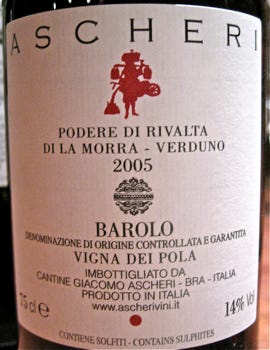
2006 Ascheri Barolo, Vigna dei Pola
The top-scoring wine of my entire trip to Piemonte, by quite a margin. Produced by Matteo Ascheri under the expert winemaking care of Giuliano Bedino, this wine lifted me out of my chair and took me to a place no other Barolo did in my wine tour.
Call this “Beyond Barolo” and you will understand what this wine is about; other-worldly.
This 2006 wine is not yet released (which is why a different vintage label is shown above), and probably will only make its way to the US market by this time next year; but it is something to put on your calendar and circle: “Get this wine when it is released in the fall of 2010!”
Matteo says that the 2006 vintage for Barolo (which is made from the Nebbiolo grape) is the best vintage in the region in the last 20 years. It shows in this wine, a near-perfect example of great fruit turned into great wine. This wine has fresh ripe fruit flavors, pronounced muscle, chewy meat, flowery scents, rich fat and all of this is wrapped in an elegant package, handsomely balanced. 98 points.

2006 Ascheri Barolo, Sorano
Like the two other 2006 Ascheri Barolos reviewed here, this particular wine has not yet been released. It, too, will only hit the US market in the fall of 2010, or even later. But what a wine to wait for!
Winemaker Giuliano Bedino says this is his favorite of the three Barolos he fashioned in 2006. This wine has extreme structure, more tar, and more balsamico essence than either of the other two Barolos (Vigna dei Pola, above, or Coste Bricco, below). 93 points.
2006 Ascheri Barolo, Coste Bricco
Ascheri only produced 325 cases of this stupendous wine and it won’t be released until the fall of 2010, so make a point of telling your favorite wine shop to put you down for a case upon release (which is why a different vintage label appears above).
This is a blend of Nebbiolo fruit from two blocks on a Langhe hillside – the Bricco portion, or top-most crown of the hill, and the Coste portion, or middle strata of fruit on the hillside.
Winemaker Giuliano Bedino says this wine needs 15 to 25 years to mature; today it appears to be a Barolo on steroids with lots of everything to reach its predicted old-age in tact; it has loads of fruit, loads of spice, and loads of stuffing. 92 points.
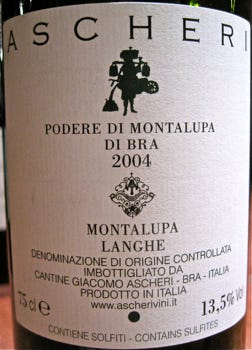
2004 Ascheri Montalupa Langhe
Italian DOC laws prohibit the winery from putting the word “Syrah” on the label of this purple potion, but that’s exactly what is in the bottle – 100 percent Syrah from the Langhe wine region. And oh, what a fabulous Syrah this is!
The aroma of pure Syrah jumps out of the glass, shouting “I AM SYRAH!” and it never lets you forget this fact. While still too young to exhibit tar, or leather, or any of the elements of a classic older Syrah, this is a tremendous effort, certainly the best Italian Syrah that I have ever tasted. 92 points.
PAOLO CONTERNO
Daniele Pallaro, responsible for commercial contacts, and his uncle, Giorgio Conterno, winemaker at Paolo Conterno, who looks a lot like songwriter Paul Simon.
There are six Conterno families making wine in Barolo country; at one time several may have been related, but this is not the case any longer today.
I enjoyed s morning with Giorgio Conterno, sixth generation winemaker, and his nephew, Daniele Pallaro, who graciously opened the best of the best of their wines for me.
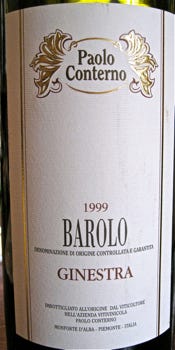
1999 Paolo Conterno Barolo Ginestra
Most Barolos, made from the Nebbiolo grape, are meant to age for a long period, easily 10 years. In some exceptional vintages like 2006, wine lovers may have to wait 15 or 20 years before popping the cork to experience the full complexity and “reveal” of Piemonte’s top wine.
To show how a ten-year-old Barolo from an exceptional vintage can age, Giorgio Conterno, winery owner, and his nephew, Daniele Palaro, opened a 1999 Barolo for me.
All the classic Barolo aromas leapt from the glass – tar, mushrooms, ripe red fruit, even a hint of chestnut. Many of these same notes were found all the way through the sip and eventual swallow (this stuff was too good to spit out). The overall impression of this wine: one of silken sensuality. 94 points.

2005 Paolo Conterno Barolo Ginestra
Giorgio Conterno says that he makes Barolos to strut their stuff at age 10, but that certain vintages, like 2005, just happen to drink beautifully at a much earlier age.
I couldn’t agree more, especially with this wine. It already has a gorgeous aroma; you can virtually “taste the vintage,” as Giorgio puts it.
My notebook highlights this wine’s elegance, dark ripe fruit and twice I used and underlined the word “stunning” to describe the wine’s middle palate and finish. 93 points.
Enough, already with the wine labels! This was going to be a shot of the 2008 Paolo Conterno Barbera D’Alba, Ginestra but I’m already bored with the wine labels, and I figure so must you be So instead, here’s a sweet shot of Giorgio’s old dog.
2008 Paolo Conterno Barbera D’Alba, Ginestra
Very spicy, very racy, very tasty. (Sounds like Twitter tasting notes!) Gobs of dark ripe fruit, spicy cherry and appealing length. 92 points.
ODDERO
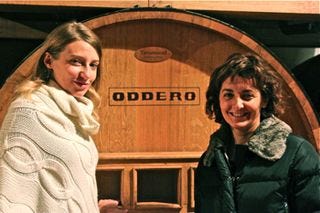
There are no XY chromosomes at Oddero Winery. Owner/winemaker Cristina Oddero (right above) and her niece, Isabella Boffa (left above), who cares for commercial aspects of the business, are turning out spectacular wines in La Morra.
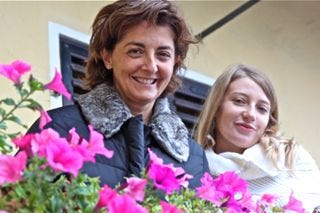
I’d summarize their efforts by saying that they’re producing 10,000 cases of liquid poetry, based on the wines I tasted.
2001 Oddero Barolo, Mondoca Bussia Soprana
An ambrosial wine. Truffles leapt from the glass before I even had it to my nose; scents of rich white, just shaved truffles, mixed with great ripe red fruit. There is lovely extraction here and the finish is redolent of fresh porcini. 94 points.
2005 Oddero Barolo, Rocche di Castiglione
Cristina only made 200 cases of this unfined, unfiltered, thrilling Barolo, which had me note “wow!!” with two exclamation marks in the margin of my notebook.
I loved the truffle scents, and full onslaught of fresh ripe red fruit. Plenty of tobacco and geranium scents, too, and the texture was silken and elegant. 93 points.
2005 Oddero Barolo, Bussia Soprana, Vigna Mondoca
The fruit for this Barolo comes from vines in nearby Monforte D’Alba. The wine has a new-world style, yet exhibits many old-world charms, including hints of tobacco, and a mint-y, almost eucalyptus-type top note. 92 points.
SOBRERO FRANSESCO & FIGLI
Settimo (named because he was the 7th child in his family) and his son, Flavio, two generations of Sobreros. They make old-style, seriously rich, gorgeously balanced, traditional Barolos.
Young 27-year-old Flavio Sobrero has taken over the reigns at this three-generation winery from his dad, Settimo, and is doing a masterful job at building on his family’s former successes.
Sobrero’s next-generation leader, Flavio Sobrero.
Some of Flavio’s winemaking processes are, to say the least, unique, but they result in wines of rich depth and alluring texture.
Sobrero is often considered one of the last hold-outs of “traditional-style” Barolo winemakers, which just may be why I love what Flavio is producing. Some things you just can’t improve on, and the way they used to make Barolo – and which Flavio continues – is one of them.
2005 Sobrero Barolo, Ciabot Tanasio
A “ciabot” is a farmer’s tool shed. Young Flavio Sobrero’s ciabot must be where he keeps his winemaking secrets, because this wine has plenty of them.
The wine is a blend of fruit from three different vineyards in Castiglione Falletto; but how does Sobrero load the blend with such complexity, such charm, such spice, and such pleasure?
There are no hints of the typical scents, or flavors, you expect in a Barolo – no mushrooms, no truffles, no tar – and yet this is not a New World Wine by any stretch of the imagination. 94 points.
2007 Sobrero Barbera D’Alba, Villero
A delicious, rich, fruity, elegant example of Barbera – and when was the last time you saw anyone describe a Barbera “elegant?”
I loved the silky texture of this wine and its delicious finish, as much as I did its flavors. 92 points.
ENOUGH WITH ALL THE NUMBERS AND SCORES!
WE INTERUPT THIS LONG POSTING TO BRING YOU A MOMENT OF VISUAL BLISS.
THIS IS WHAT THE LANGHE DISTRICT LOOKS LIKE IN A RIOT OF FALL COLORS.
PIEDMONT HAS TO BE THE MOST BEAUTIFIUL WINE REGION I HAVE EVER VISITED – AS THESE SHOTS ATTEST.
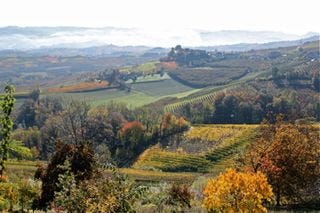
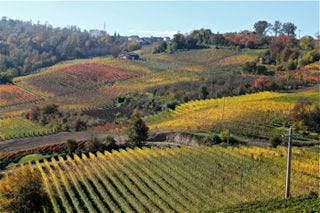
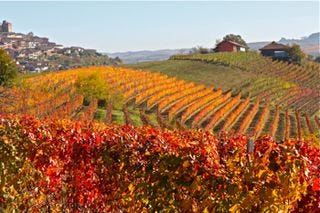
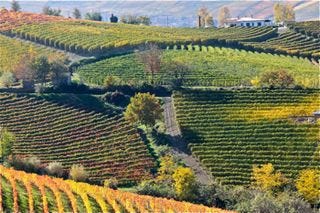
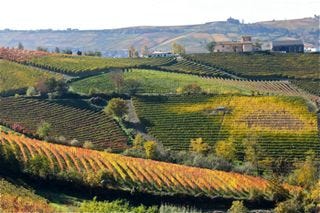
WE NOW RETURN TO THE SERIOUS BUSINESS OF MACRO-REVIEWING THE TOP WINES OF MY TWO-WEEK TRIP THROUGH PIEMONTE.
MALVIRA
One of the breathtaking vineyards that surrounds Malvira and its accommodation facility for guests, Villa Tiboldi.
Napa Valley has done such a great job of marketing itself and its wines that the public generally assumes that the wines of other California regions, like even next-door Sonoma, must be inferior.
This is what happens when you cross the Tanaro River in Piedmont, and head north of the fabled Langhe region; you enter the” Sonoma of Piedmont.” Wine drinkers just assume that the wines will be inferior. But they’d be wrong, certainly based on my experience.
A
2008 Malvira Trinita Arneis
The only white wine to make my Top Wines Wine List, and what a doozy this wine is!
I enjoyed this stunning white wine at a four-hour luncheon at Villa Tiboldi, an agriturismo inn/dining room on the Roero side (left bank) of the Tanaro River.
Usually, Arneis is filled with licorice and/or fennel top notes, but this beaut is vinified to guard all the inherent tropical fruit notes. Bright lemon jumps from the rim to the nose – lemon juice, lemon peel, lemon rind, lemon everything except lemonade.
Hard to imagine that this wine has seen any oak, but it has had a judicious tweak of 10 percent new oak which helps set up the stepped profile and lengthy finish. 93 points.
2006 Malvira Langhe Nebbiolo
Aged 18 months in French oak, this very well structured wine has a stupendous bead, a honed focus; there’s a striking attack, a good middle palate of pleasure and a definite, lingering finish. I liked the whole package. 92 points.
2005 Malvira Renesio Nebbiolo
Wow, these folks from Malvira are making some fabulous wines.
This 100 percent Nebbiolo spent two years on wood and two years in bottle before being released. My summary note says it all: “A fabulous wine!” 92 points.
GIANFRANCO ALESSANDRIA
Bruna (mom) and Vittoria (daughter) Alessandria.
I found the wines of Gianfranco Alessandria as warm and inviting as his family. Gianfranco’s wife, Bruna, and their daughter, Vittoria, graciously walked me through a tasting of their contemporary portfolio. Like the wines, the family exudes charm, finesse, and a particular joie.
Gianfranco was in New York the day I visited the family winery in Monforte D’Alba, but Bruna and Vittoria made me feel at home, pouring generously from their selection of wines.
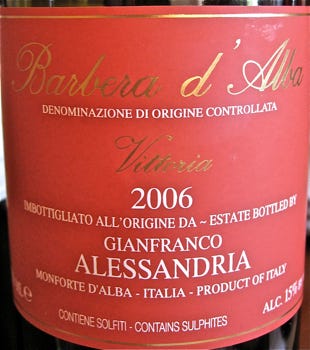
2006 Gianfranco Alessandria Barbera D’Alba, Vittoria
Named after the precocious 19-year-old daughter who helps her parents run the winery, this wine has the kind of deep purple color that belongs in a rich, warm, wool sweater in a Milan fashion window.
This Barolo is aged for 18 months in French oak, of which 45 percent is new. The wine is round in the mouth, supple, complex and the finish is long and filled with plum and dark cherry flavors. 93 points.
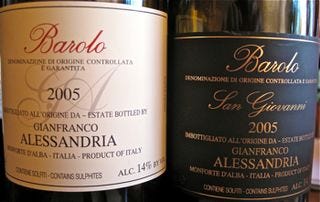
2005 Gianfranco Alessandria Barolo San Giovanni
An extremely elegant, focused Barolo, filled with dark cherries all along the swallow (hard to spit this one…), suggesting that it will age seamlessly, not to mention sensually. 92 points.
BARTOLO MASCARELLO
A contemporary shot of Maria Teresa Mascarello at her very traditional winery in town of Barolo.
The last time I was in this cantina, in Barolo, Piedmont, il padrone, Bartolo Mascarello, was alive and well and making guests feel right at home.
In fact, on a visit in 1982, Bartolo descended into his cellar, producing a 30-year-old, perfectly aged, 1952 Barolo, which he opened. It turned out to be one of the top five wines I have ever tasted in a 40-year career of tasting, and writing about, wines.
So it was a bit like a pilgrimage to return to the scene of that experience. Bartolo died in 2005 and his daughter, Maria Teresa, has assumed winemaking responsibilities.
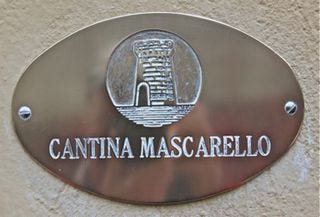
2005 Bartolo Mascarello Barolo
The 2005 Mascarello Barolo has earned high praise in recently published wine journals, including the influential, L’espresso Italian wine guide.
But I thought the bottle Maria Teresa opened for me was slightly compressed and way too polished, not like the Barolos of yesteryear. The tannins were soft, and the wine very cherry. This wine appears awfully approachable, something I doubt Bartolo would have designed for his wine. 92 points.
That’s all folks!

